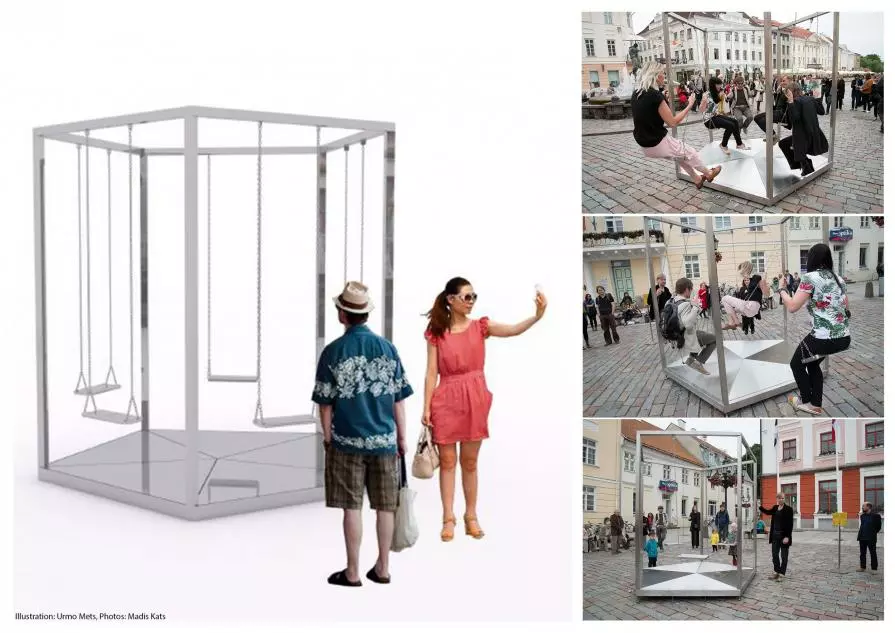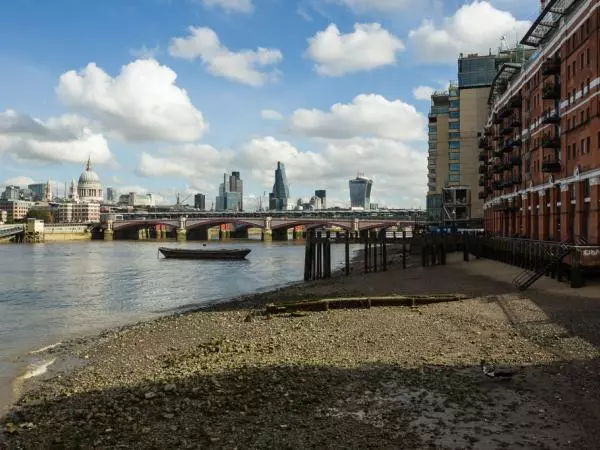
SWING
Authors: Kaisa Eiche, Urmo Mets
Description of the installation:
1. The swing can be disassembled and reassembled. The installation consists of the following structural elements: upper and lower frame and posts, chains, seats. The set of five swings is designed as a pentagram with the seats facing each other. The installation is functional. If we have 2-5 people using the swing at the same time, they are inevitably going to bump into each other. All metal parts of the construction are made from stainless steel. There are no sharp edges for better safety. The weight of one swing seat is 2,5 kg; the framework weighs about 150 kg; the construction is stabilised with about 400 kg of bricks that are hidden inside the floor, with the whole installation weighing about 550 kg.
2. Activity: social interaction in physical (swinging) and virtual space (QR code, information feed: social media, reviews etc)
3. QR code (The Facebook event, collected documentation published on a website – coming soon)
The SWING expresses the ideas of freedom and importance of considering the ones living next to us. The construction of the minimalist installation is made from stainless steel, making it aesthetically pleasing and reflective of the city life. While being very simple and playfully functional, the installation also makes us consider the aspects of existing side by side in the society and the decisions we make every day. The swing is open for anyone to view and reflect on.
Kaisa Eiche has worked as project manager for art galleries and art events for seven years in Tartu. Working with the public sector, she is familiar with the ethical issues that often come up with the use of public spaces. Day-to-day work with the authorities, cultural financers and organisers led to the idea and creation of the swing.
Urmo Metsa’s Master’s Thesis „A Guide to Analyse and Enhance Urban Public Spaces in Estonia“ discusses the planning of urban spaces in Estonia and how public interest does not get considered enough. He offers methods for mapping the strengths and weaknesses of the urban public space. The aim of the project is to help Estonian local governments and communities to improve their public spaces. Being an architect, Metsa is against political decisions or putting our economic interests first when talking about public spaces.
http://www.cca.ee/en/center/170-archeological-festival-a-2nd-h
Kaisa Eiche (born 1982) lives, studies and works in Tartu, Estonia. She graduated from Tartu Art University as a photographer in 2007 and started her semiotics studies at Tartu University in 2011. Eiche is the project manager for the „Y-galerii“ art gallery (since 2007) and leads the international modern art festival ART IST KUKU NU UT (2009-2014) together with independent curator Rael Artel. She has curated exhibitions of artists of the younger generation and held reading groups and discussions on various social topics. She has organised the “Mood-Performance-Tants” festival (2007–2008) in Tartu, been active with the Pärmivabrik events (2008-2010) as a member of the culture factory and organized the performative conference format “International Conference, Scientific Conference ” (2008–2012) together with linguist Dr Erkki Luuk. Eiche is one of the founders of the local cultural newspaper Müürileht. She is also active as an artist and writes exhibition reviews.
http://www.artistkukunuut.org/
http://ygalerii.blogspot.com/
Urmo Mets: http://www.arhliit.ee/koosseis/liikmed/liige/418/
 Share / Save
Share / Save







Commenti 0
Inserisci commento